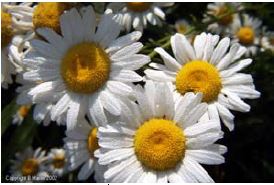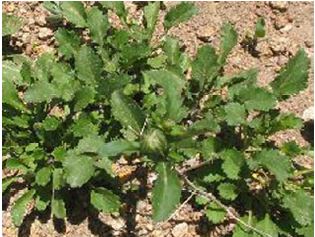Introduction
Oxeye daisy (Chrysanthemum leucanthemum or Leucanthemum vulgare) is a perennial in the sunflower (Asteraceae) family. A native of Eurasia, it is sold as an ornamental, but has escaped cultivation. Common names include white daisy, field daisy, and Marguerite. Horticultural cultivars are weedy and should be avoided, including ‘May Queen’. Oxeye daisy is often sold in meadow, wildfire restoration, and erosion control seed mixes.
Identification
Oxeye daisy resembles a typical daisy. The 1½ to 2 inch flower heads are borne individually on slender stems from June through August. Their yellow centers are surrounded by 20 to 30 white radiating petals, which are slightly notched at their tip (Figure 1).
The prostrate stems produce 1 to 3 foot tall, upright, flowering stalks that are often grooved and sometimes branched near their ends. Leaves are progressively smaller toward the end of the stem. Basal (lower) leaves are lance-shaped with "toothed" margins. Leaf petioles (stems) may be as long as the blades. The upper leaves are alternately arranged, narrow, and may clasp the stem. The 1/16 inch long seeds are brown to black with 8 to 10 white ridges down their sides.
Figure 1. Oxeye daisy has a yellow center with 20 to 30 white petals.
Copyright B. Marlin, 2002

Habitat
In the Western and Pacific United States, oxeye daisy is found in pastures and meadows, but it also grows along roadsides, in abandoned fields, and in waste areas. Oxeye daisy will grow in neutral or basic soils, with optimal growth in soils ranging from 6.5 to 7.0 pH. It is usually found in moist areas, but will tolerate drought, once established, and light frost. Oxeye daisy forms dense stands decreasing plant diversity and limiting grazing options as palatable forage species are crowded out.
Impact
Oxeye daisy is a prolific seed producer, usually shedding 2,000 to 4,000 seeds per plant with a high of 26,000 seeds on one plant. Seeds may be viable and ready to germinate within ten days after flowering. Germination occurs throughout the growing season; however, seeds that do not sprout may remain viable in the soil for several years. Reproduction and spread is primarily by seed, but the crown, rhizomes, and fibrous root system are also important in producing new plants.
Oxeye daisy’s greatest impact is on forage production in infested meadows and pastures. Wildlife and cattle avoid grazing and walking in infested areas since the plant irritates their noses, mouths, and legs. Very few animals eat oxeye daisy preferring to eat more desirable and palatable species first, which reduces competition for oxeye daisy allowing it to crowd out other plants. With the loss of desirable forage, oxeye daisy fills in, decreasing the land’s carrying capacity and reducing wildlife habitat (Figure 2).
Figure 2. Oxeye daisy may spread rapidly and crowd out desirable native and forage species.

Management
Prevention
Always clean seed and plant parts from equipment and vehicles after being in an infested area. Clean boots, pants and other clothing too. Inspect and clean the feet/hooves and coats/fleeces of domestic animals when they have moved through infested areas. Sow only clean, weed-free certified seed. Do not sow wildflower seed mixes containing oxeye daisy.
Mechanical Control
Hoe or hand-pull seedlings and young plants (Figure 3) for effective control of small patches and stands. This is most effective when done before oxeye daisy flowers and seed is dispersed. This prevents reinvasion by seedlings. Larger infestations require repeated cutting and pulling during the growing season for several years to effectively reduce oxeye daisy. Mowing oxeye daisy will not eradicate the weed, but it limits the spread of seed, when timed properly.
Figure 3. Oxeye daisy rosettes.

Mow once after the plants produce a flower stalk (bolt), but before they flower. It is important to mow again a month later to prevent flowering later in the season. Mowing stimulates growth of lateral branches and rhizomes and is most effective when used in combination with herbicides. Mowing produces a more uniform plant with greater leaf area to better absorb herbicides.
Cultural Control
Re-establishment of desirable vegetation is needed in order to successfully manage oxeye daisy. Perennial grasses are effective competitors, particularly tall species that shade oxeye daisy, making it a weaker plant. Light grazing encourages growth of grasses and keeps pastures and rangeland vigorous. Overgrazing an area reduces competition and encourages oxeye daisy recruitment. Grazing sheep or goats over many years is effective, and probably most effective in combination with an integrated herbicide and replanting regimen.
Biological Control
None.
Chemical Control
Chemical control is difficult. Mowing several weeks before an herbicide treatment may stimulate more uniform vegetative growth and greater leaf area to absorb herbicide products.
Montana researchers have shown that oxeye daisy is tolerant to 2,4-D at the legal rate of 2 lbs/acre/year. In southwestern Montana, 1½ pints/acre of picloram (Tordon®) plus 1 quart/acre 2,4-D gave 100 percent control for two years on one site. However, researchers do not recommend this treatment for long-term control. Transline® is also labeled for use on oxeye daisy and should be applied at ⅓ to 1 pint/acre when plants are young and actively growing.
Because oxeye daisy is not a superior competitor for nutrients, some researchers believe fertilizer applied in combination with herbicides will enhance the growth of grasses and hinder oxeye daisy performance. In a mountain meadow in eastern Washington, nitrogen applied at 80 lbs/acre (with no herbicide) was the most cost-effective chemical treatment for oxeye daisy. Forage production increased by 500 percent when a high level of nitrogen fertilizer was applied. Oxeye daisy was still present, but its impact was greatly diminished.
References
Colorado State University Cooperative Extension. Noxious Weeds in Gilpin County, Oxeye daisy. 03/20/2006.
Montana State University Extension Service. Oxeye Daisy. MontGuide fact sheet #200002.
Photographs
Figure 1: Photo by Bruce Marlin. 3/20/2006 Cirrus Image.
Figure 2: Photo by Mary Ellen (Mel) Harte Forestry Images.
Figure 3: Photo by Irene Shonle, Gilpin County Director, Colorado State University Cooperative Extension.
Johnson, W. and Macknet, D.
2006,
Identification and Management of Oxeye Daisy,
University of Nevada Cooperative Extension


